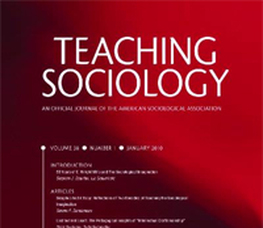|
Since launching The Sociological Cinema in September 2010, we have cataloged over 450 videos for teaching and learning sociology, and written numerous blog posts about teaching with video and other multimedia. We have marveled at the explosion of course-relevant videos now available on the Internet and the ways that technology has enabled the production and sharing of videos previously unavailable to instructors. Along the way, we have continuously reflected about how these videos can be useful in an educational context.
One of the items resulting from this work has been a Teaching Sociology article, published earlier this month. Written with our friend and colleague Michael V. Miller, the article outlines a pedagogy to facilitate effective teaching with video. First, we describe special features of streaming media that have enabled their use in the classroom. Next, we introduce a typology comprised of six overlapping categories (conjuncture, testimony, infographic, pop fiction, propaganda, and detournement). We define properties of each video type and the strengths of each type in meeting specific learning goals common to sociology instruction. We conclude by discussing the importance of a video pedagogy for helping instructors to employ video more consciously and efficiently. The full article can be found on the journal's website, but we have summarized our video teaching typology in the table below. The table is meant to convey the diversity of video clips available to instructors for teaching sociology. As you can see, it extends far beyond the traditional documentary or feature film. In addition to describing each video type and the subcategories that are available in it, we offer a sample of learning goals for teaching with the type. Note that the learning goals are not mutually exclusive, but some types lend themselves particularly well to specific learning objectives. The last column links to several examples catalogued on The Sociological Cinema.
As we noted in the article, the current moment is unique for teaching sociology. Innovations in information technologies, the massive distribution of online content, and changing student expectations have called forth video to join textbook and lecture as a regular component of course instruction. As technology declines in cost and increases in ubiquity, instructors and students alike have access to online troves of video. A video pedagogy, which draws on breaking news analysis and biting satire, while routinely deploying pop culture images and state-of-the-art graphics, can go a long way toward conveying complex sociological insights and making sociology more meaningful. With this framework that outlines how video can be conceptually differentiated and how certain kinds of video are particularly well suited for achieving given learning objectives, we hope to help push this conversation forward.
Paul Dean Comments are closed.
|
.
.
Tags
All
|

 RSS Feed
RSS Feed